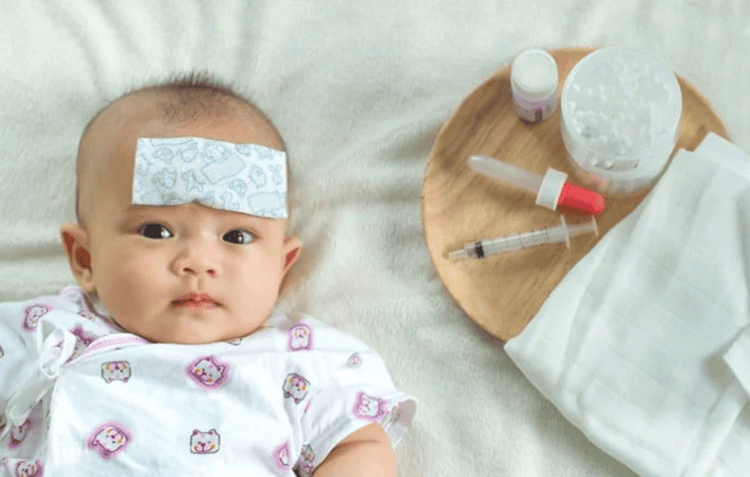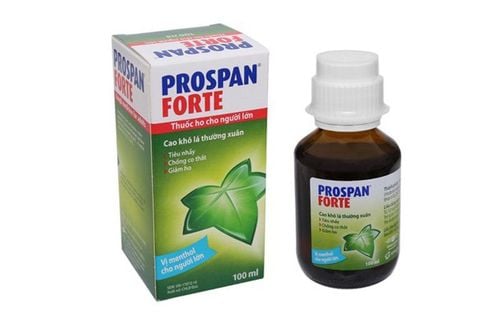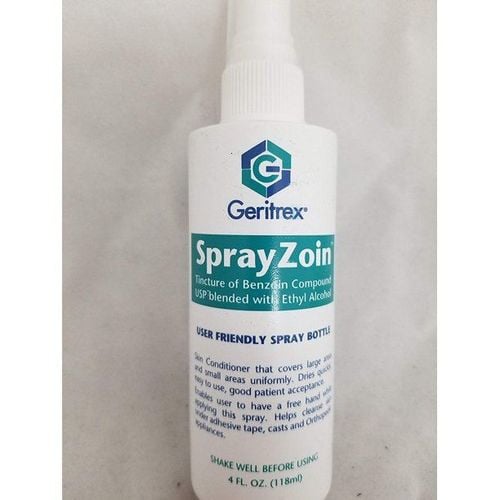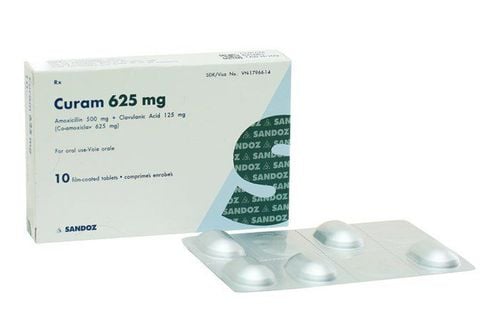This is an automatically translated article.
The article was professionally consulted by Specialist Doctor II Chung Thi Mong Thuy - Pediatrician - Neonatologist - Department of Pediatrics - Neonatal, Vinmec Central Park International General HospitalNewborns are very susceptible to upper respiratory infections, especially during the change of seasons, cold weather or polluted environment. Infants and young children with the disease also cause more complications than older children. Therefore, parents need to pay attention to some special things when taking care of newborn babies when they have upper respiratory infections. Parents need to master the signs of the disease to detect early intervention to limit serious complications and how to take care of babies with respiratory infections to help them recover quickly.
1. What is upper respiratory tract infection in infants?
The respiratory system in the human body is defined starting from the anterior nostril to the alveoli in the lungs. The upper respiratory tract includes the nose, pharynx, pharynx, sinuses, and larynx. The function of the upper respiratory system is to take in outside air, humidify, heat, and filter the air before it enters the lungs. When children have inflammation, they can get diseases such as rhinitis, pharyngitis, tonsillitis, laryngitis, bronchitis...In fact, a perfectly healthy child can get an upper respiratory tract infection at any time. any age or at any time of the year. Even an observational study has reported that most children have at least 7 colds before their first birthday. If children in childcare classes, classes or have contact with other children with upper respiratory infections, the possibility of infection increases.
Newborns with weak immune systems, especially premature babies or babies who are not breastfed because of a special medical condition of the mother (such as a mother with cancer undergoing chemotherapy or an advanced tuberculosis mother...) or the mother does not have milk. This is also the reason why babies are very susceptible to viral infections of respiratory diseases (folk or cold).

Trẻ sơ sinh dễ bị viêm đường hô hấp trên
2. What are the signs of upper respiratory tract infection in infants?
Newborns with upper respiratory tract infections often have symptoms of runny nose, sneezing, stuffy nose, low-grade fever, little cough and little regurgitation, wheezing. The onset of the disease is usually mild, in some cases, they can progress to more severe, causing accompanying lower respiratory tract inflammation. If the child has bronchiolitis, bronchitis, pneumonia that gets worse and is not controlled, it can lead to respiratory failure and life-threatening.The first symptom of upper respiratory tract infection in newborns is usually a clear, liquid and small amount of water in the nose, but later, if there is a possible superinfection, it will turn cloudy, denser and yellow in color. , blue for the next few days. When a child has a superinfection, it is necessary to take the child to a doctor for examination and early medical intervention to prevent serious complications later.
In addition, the symptoms of upper respiratory tract infection in infants may be accompanied by other symptoms such as:
Crying
Fever
● Cough, especially at night, dry cough or cough with sputum
Sneezing
● Poor feeding or aborting
● Shortness of breath, rapid breathing
Wheezing
Difficulty sleeping
Drowsiness
● Red, watery eyes

Sốt là một trong các dấu hiệu viêm đường hô hấp trên ở trẻ sơ sinh
3. What causes upper respiratory tract infections in infants?
In the air, there are more than 200 viruses circulating, which can cause respiratory infections in infants. Most of these virus strains mainly start to get sick in the autumn - winter, and once infected, the child's body will create passive immunity to help them increase resistance in the following infections.This pathogen is everywhere in the air and is very easily spread by respiratory droplets and secretions from one person to another. When a person is infected with the virus, whether or not they are showing disease, the droplets when coughing, sneezing, and nasal secretions all contain the virus, thereby causing illness to others. In particular, the virus can survive for a long time on surfaces such as furniture, doorknobs, floors, and toys. In other words, if a parent or caregiver is sick or cares for a child with infected hands, it is possible to pass the disease on to the child.
In breast milk contains IgG antibodies, enzymes and many other important nutrients that strengthen the child's immunity, creating conditions to help children fight diseases and develop healthy. This is a protective barrier that helps children avoid pathogens that cause viral and bacterial infections.
4. How to take care of a newborn with upper respiratory tract infection at home?
Because the causative agent of respiratory illness in children is a virus, treatment and care mainly reduce symptoms, help children feel more comfortable, and quickly relieve symptoms. Here are guidelines for what parents and carers should and shouldn't do:4.1 Do's Properly regular hand hygiene with a quick sanitizer or soap under running water for at least 20 seconds when caring for and after cleaning a child to prevent upper respiratory tract infection from spreading to other children.
● Raise the baby's head slightly above the body and legs to help the baby breathe easier. Parents do this with a soft pillow placed under the head, thin padding with the whole back for the child to follow down to the feet.
● Provide enough water and nutrients for children. Make sure the baby gets enough milk during the day and even increase it to 10-20% of the daily requirement if the child has a fever or is crying a lot, wheezing and stuffy nose a lot.
● Keep the nasopharyngeal area clear. Suction mucus in the baby's nose and throat when listening to children wheezing, stuffy nose with special tools for babies. Physiological saline can be used if the sputum is thick to help thin the mucus and make it easier to manipulate.
● Keep the air moist with a humidifier, reduce irritation to the respiratory mucosa, limit secretions, and edema. Make sure the room temperature is suitable for the child, not too cold, not too hot, average 26-28 degrees C
● Wear light and airy clothes if the child has a fever. Reduce fever for children actively with acetaminophen when the child has a high fever > 38.5 degrees with a dose depending on the weight of the child. If the child is fussy or vomiting, an rectal suppository can be used. Combined with giving children more water (boiled water, breast milk....) will help reduce the child's fever quickly and better.

Phụ huynh hạ sốt cho trẻ theo hướng dẫn của bác sĩ
● Do not arbitrarily give children more than the fever-reducing dose when it is not controlled. Never use aspirin to lower a child's fever without a doctor's prescription.
Cough and cold medicines should not be given to children under 2 years of age.
● Do not let the child sleep on their stomach, because this position will increase the risk of airway obstruction, easily leading to sleep apnea when the child is suffering from respiratory inflammation.
In summary, upper respiratory tract infections caused by viruses are very common in neonates. Even babies who are exclusively breastfed are susceptible to the disease, although the infection rate is lower than formula-fed babies due to their better immunity. Because upper respiratory tract infection alone can progress to more serious diseases, parents need to take proper care of the child, closely monitor the child when signs of upper respiratory infection become severe to take the child to the doctor. and timely intervention.
With many years of experience in examining and treating diseases in children, now the Pediatrics Department at Vinmec International General Hospital has become one of the major health care centers, capable of examining , screening and treatment of many specialized diseases in children. Therefore, if the child has signs of respiratory infection, parents can take the child to Vinmec International General Hospital for examination and receive support and advice from doctors and nutritionists. .
Parents should also add some supporting foods containing lysine, essential micro-minerals and vitamins such as zinc, chromium, selenium, B vitamins,... nutrients while supporting the immune system, enhancing resistance, reducing the risk of upper respiratory tract infections, bronchitis, flu,...
Lysine is essential for the development of children Lysine promotes the production of digestive enzymes to stimulate children to eat better and digest easily and effectively, increase food metabolism, and absorb maximum nutrients from food. Fortifying lysine for babies also helps The body creates antibodies, develops resistance to help relieve cough and thin sputum in children.
Parents can learn more:
Why do you need to supplement Lysine for your baby?
Please regularly visit Vinmec.com website and update useful information to take care of your baby and family.














